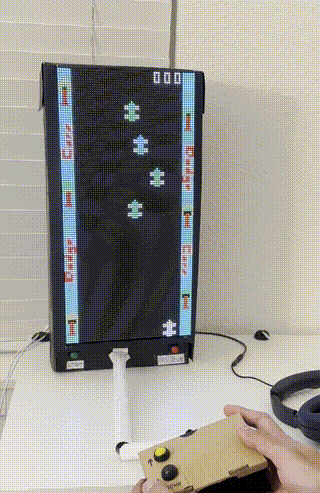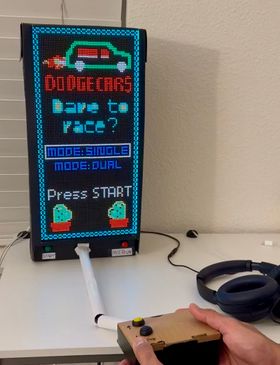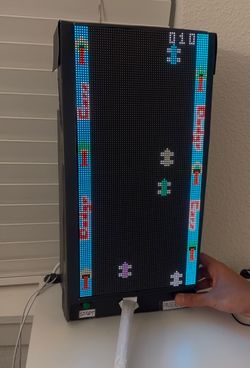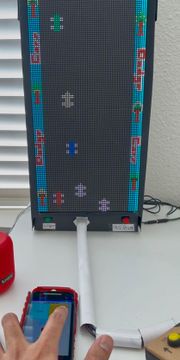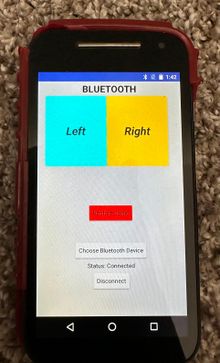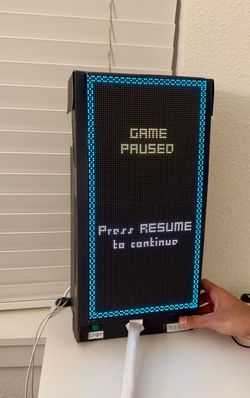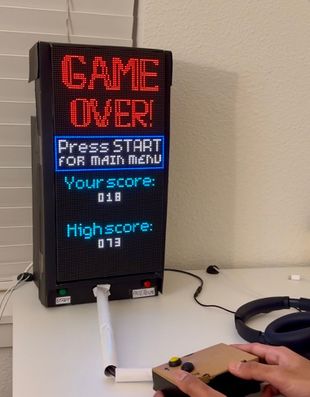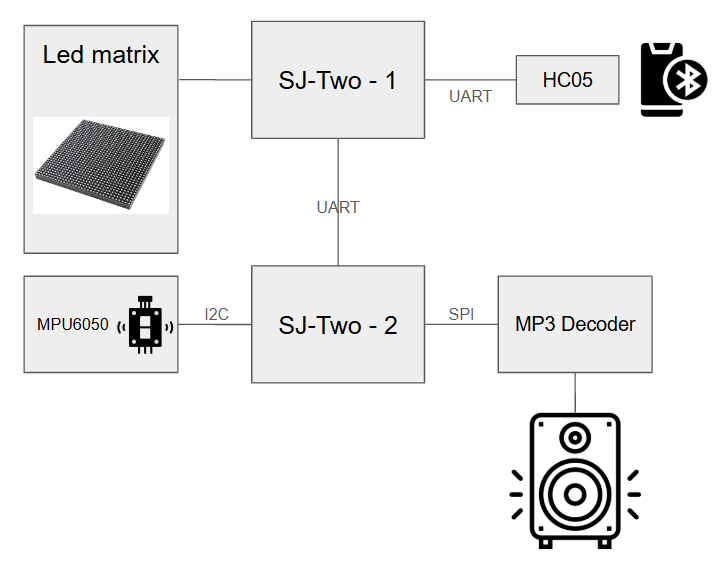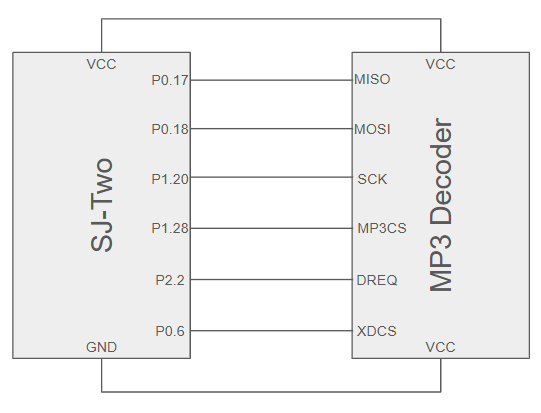F24: Dodge Cars
Contents
Hardware and gameplay snapshots
Abstract
Dodge Cars is a fast-paced action game where players control a vehicle to avoid collisions with incoming obstacles. The objective is to maneuver the car left or right, dodging other cars or objects as they approach. As the game progresses, the speed of obstacles increases, adding difficulty. The game utilizes a 64x64 LED matrix display for visuals, with an SJ2 board for processing. A button allows players to access the menu, navigate, and pause the game (or optional photosensor). An ultrasonic sensor detects if the player is sitting too close to the screen, warning them to adjust their position. An accelerometer is used to control the left and right movements of the player car. The final score of the player will be displayed at the end of every game and a speaker attached to the board will generate the game sounds.
Introduction
Dodge Cars is an engaging and fast-paced action game designed to test players' reflexes and coordination. Players navigate a car through a dynamically changing environment, dodging incoming obstacles that become increasingly difficult to avoid as the game progresses. This interactive experience leverages modern hardware and creative gameplay mechanics, delivering a fun and challenging game suitable for players of all ages.
The game is powered by a 64x64 LED matrix display that provides a vibrant, retro-inspired visual experience. An SJ2 board acts as the central processing unit, seamlessly handling the game's inputs, outputs, and real-time logic. Players control the movement of their car using an accelerometer, adding an immersive, physical dimension to the gameplay. Safety and accessibility are also prioritized, with features like an ultrasonic sensor to promote proper player posture and a button or optional photosensor for intuitive menu navigation. To enhance the overall experience, a speaker generates immersive game sounds, and the final score is displayed at the end of each session, encouraging replayability.
Objective
The primary objective of this project is to develop an interactive game system that combines hardware and software components to deliver a compelling gaming experience. Key objectives include:
- Design an engaging game loop where players must dodge obstacles using precise control of a car, with increasing difficulty as the game progresses.
- Utilize modern hardware components like a 64x64 LED matrix for visuals, an accelerometer for motion control, and an ultrasonic sensor to enhance player safety.
- Provide intuitive user interactions through menu navigation using a button or photosensor, along with clear audio-visual feedback from the speaker and display.
- Promote player engagement and challenge by showcasing the final score at the end of each game and encouraging improvement through replayability.
- Integrate safety measures by alerting players if they are sitting too close to the screen, fostering healthier gaming habits.
This project aims to blend creativity, engineering, and user-centric design into a fun and immersive gaming system that highlights the potential of embedded systems in interactive applications.
Team Members & Responsibilities
- Shreyas
- Working on Accelerometer Sensor
- Teja
- Working on MP3 decoder
- Navaneeth
- Working on Game logic and LED screen
Schedule
| Week# | Start Date | End Date | Task | Status |
|---|---|---|---|---|
| 1 |
|
|
|
|
| 2 |
|
|
|
|
| 3 |
|
|
|
|
| 4 |
|
|
|
|
| 5 |
|
|
|
|
| 6 |
|
|
|
|
| 7 |
|
|
|
|
| 8 |
|
|
|
|
| 9 |
|
|
|
|
| 10 |
|
|
|
|
Parts List and Cost
| Part | Model | Quantity | Cost |
|---|---|---|---|
|
|
|
|
|
|
| |
|
|
| |
|
|
|
Design & Implementation
The design section can go over your hardware and software design. Organize this section using sub-sections that go over your design and implementation.
Hardware Design
Hardware Interface
In this section, you can describe how your hardware communicates, such as which BUSes used. You can discuss your driver implementation here, such that the Software Design section is isolated to talk about high level workings rather than inner working of your project.
- 1. Created a SPI (SSP0) driver to communicate with MP3 decoder and SD Card. We used the following pins:
| MP3 Decoder Pin | Pin Description | Corresponding SJ2 Pin |
|---|---|---|
| MISO | SSP0 MISO (Master In Slave Out) | P0_17 |
| MOSI | SSP0 MOSI (Master Out Slave In) | P1_18 |
| SCK | SSP0 SCK (Clock Pin) | P1_20 |
| SSEL | SSP0 SSEL (Slave Select) | P1_28 |
| MP3CS (Chip Select) | GPIO | P0_6 |
| DREQ | GPIO | P2_2 |
| VCC | VCC(3.3V) | On Board |
| GND | GND | On Board |
Software Design
Show your software design. For example, if you are designing an MP3 Player, show the tasks that you are using, and what they are doing at a high level. Do not show the details of the code. For example, do not show exact code, but you may show psuedocode and fragments of code. Keep in mind that you are showing DESIGN of your software, not the inner workings of it.
- LED Matrix:
- 1. Initialized LED matrix connected pins to board IOs.
- 2. Designed matrix driver for screen display by reading an matrix.
- 3. Designed pause menu, main menu and gameplay environment for different states of game.
- 4. Used GPIO pins as buttons as controls in main menu
while true:
if button_up_pressed:
send 'U' over UART // Up
if button_down_pressed:
send 'D' over UART // Down
delay()
- On-board Accelerometer:
- 1. Initialized I2C channels for taking the x, y and z reading from the sensor and input the readings into the LED matrix gameplay.
- 2. Used accelerometer readings as inputs for moving the car left and right during gameplay. Uses two tasks:
1. read_data Task
- Initializes I2C communication with the accelerometer
- Continuously reads X and Y axis data from the accelerometer
- Interprets the data to detect tilt (left, right, or no tilt)
- Updates a global variable (tilt_data_to_send) with the tilt direction
2. board_1_sender_task
- Periodically sends the tilt data over UART to the second board attached to the LED matrix display
- This task enables communication of tilt information to the LED matrix
- Integrated sensor with bluetooth sensor to serve as a single player control during dual player co-op.
while true:
read accelerometer data
if tilt_left:
send 'L' over UART
else if tilt_right:
send 'R' over UART
else:
send 'M' over UART
delay(small_amount)
- Bluetooth Sensor:
- 1. Used Bluetooth sensor to communicate with LED matrix display to move car left and right.
- 2. Worked as a single player control during dual player co-op.
- 3. Used as a point of reference for game restart on the game over screen(START button can also be used). This sensor uses just one task for it's computation:
while true:
if bluetooth_data_received:
if data == '1':
move_player_two_car_left()
else if data == '2':
move_player_two_car_right()
else if data == '3' and game_is_over:
restart_game()
delay(small_amount)
- Mp3 Player:
- 1. Initialize using SPI.
- 2. Check state of game and select appropriate task.
- 3. Load song from SD card into MP3 decoder.
There are two tasks, one that updates the state of the game to read data from the SD card present on the SJ2 board while the other uses a queue to receive data from the first task and relay it to the MP3 decoder.
Task 1: Mp3 Reader
const char* current_song = NULL;
while True:
Check state of game and switch to case STATE:
Updates current songname
load_song_into_queue(songname):
if freaddir(root_directory) == True:
Check for songname in directory
Read song data from mp3 file into queue
Close file && Close directory
return;
Task 2: MP3 player task
spi_cs() // Initialize SPI communication
Initialize the DREQ pin.
Enter an infinite loop:
xQueueReceive(song_data)
Iterate over each byte in the chunk:
Check DREQ pin to see if the decoder is ready to receive data
exchange_data(byte)
spi_ds()- 2. Set device with selected sd card and volume.
Implementation
This section includes implementation, but again, not the details, just the high level. For example, you can list the steps it takes to communicate over a sensor, or the steps needed to write a page of memory onto SPI Flash. You can include sub-sections for each of your component implementation.
Testing & Technical Challenges
1. We initially faced issues with the extracting the readings from the accelerometer. It took us some time to understand the I2C communication between the SJ2 board and the sensor. When we tried printing the gyroscope and accelerometer values using MPU6050, we started getting just zero values. So we had to make sure we are using the right registers for power management, MPU6050, gyroscope configuration register and the starting register for gyroscope data.
2. We started having issues with the MP3 decoder as well. Though the SD card was being detected by the MP3 decoder, the XDCS pin on the MP3 decoder was not sending audio data to the VS1053B chip to be decoded. We managed to fix this issue by attaching the MP3CS pin to the SSEL pin on the board and using a separate GPIO pin to control the XDCS pin.
3. We faced issues with the LED matrix board. The perfectly working board started flickering all of a sudden. This was because there was an unwanted print statement in the code which was causing this issue.
Conclusion
We used I2C, SPI, UART and other FreeRTOS libraries in our project. After doing the lab assignments and learning the theory in class, we were able to apply that knowledge to implement it in our project especially configuring an external sensor (MPU6050) and an MP3 decoder. Using these protocols, we learnt multiple ways of communicating between the board and other devices. The lab assignments helped us learn how to read an external device's datasheet and use it to debug and verify our programs. This project was a fun learning experience. This project and subject was a tough introduction to embedded systems, but it was also a fun learning experience that has given us much more confidence in being able to familiarize ourselves with unfamiliar APIs and protocols and turn it into a practical application.
Project Video
Upload a video of your project and post the link here.
Project Source Code
References
Acknowledgement
I would like to express my heartfelt gratitude to Prof. Preetpal Kang for their invaluable guidance throughout this project. The insightful lectures, hands-on lab sessions, and detailed explanations provided a strong foundation and were instrumental in the successful completion of our work. His dedication to teaching and willingness to clarify concepts made a significant impact on our learning experience.
